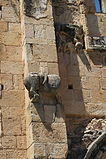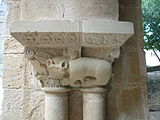Ste-Marie (Alet-les-Bains)
The former abbey church and cathedral Sainte-Marie in Alet-les-Bains , a municipality in the Aude department in the French region of Occitania , is now only preserved as a ruin. It was built in two phases, at the end of the 11th and in the second half of the 12th century. In 1862 the church ruin was added to the list of Monuments historiques .
history
The origins of the Benedictine monastery of Alet-les-Bains are in the dark. A document according to which the Abbey of Alet was founded in 813 by Berà , the Count of Barcelona , is considered a forgery. An abbot named Benoît, who was also abbot of the nearby monastery of Saint-Hilaire , is recorded for the year 970 . 1050 Grégoire Gérald is mentioned as abbot. Under him the monastery was devastated in the dispute with the Counts of Carcassonne .
In the middle of the 11th century, numerous pilgrims came to Alet to venerate a cross relic that the abbey had acquired. In 1096 Pope Urban II stayed in Alet. After his visit, the construction of the church began.
In 1318 Pope John XXII. Alet to the diocese , presumably as a counterweight to the Cathar fortresses in this remote mountain valley. The Gothic choir was built under the bishops Guillaume d'Alzonne de Marcillac (1333-1335) and Arnaud de Villard (1363-1385) . In 1531 the monastery was closed by Pope Clement VII . After that, the former abbot building was used as a bishopric.
The abbey suffered severe damage during the Huguenot Wars . In 1577 part of the building was destroyed. Until 1789 the bishops used the refectory as a new cathedral, which they dedicated to St. Benedict . In 1792 the diocese was abolished and most of the remaining buildings demolished. The Gothic choir was sold as a national good. Alet was added to the diocese of Carcassonne .
architecture
The three-aisled nave was divided into six bays . The transept arms, of which only the northern one has survived, barely protruded beyond the nave. Of the two towers, the Saint Michel tower in the north and the Notre Dame tower in the south, only remnants have been preserved. The church is adorned with rich sculptural decorations inspired by antiquity. The windows are framed by wide stone frames with carved tendrils and, like the portals, are decorated with hemispheres. Fighter and capitals are decorated with an egg stick , pearl cord and stylized leaves. Recycled sculptures are built into the south facade, a bull, a person riding a lion and a wild cat.
apse
The apse is from the Romanesque period. It is covered by an apse dome . A round arch decorated with pearl rod opens to the nave, the roof of which has collapsed. The apse was formerly embedded in the Gothic choir. The corners of the polygonal apse are reinforced on the outside by three-quarter columns , which rest halfway on high buttresses . The capitals of the columns are decorated with foliage and are connected by a richly carved cornice . On the wall surfaces, triple arcades , some with three-pass arches , rest on slender columns .
Chapter House
Three Romanesque arched openings lead to the chapter house . The Annunciation is depicted on two capitals at the entrance . Mary sits on a throne, the Archangel Gabriel is on the left and the Evangelist Luke on the right . The scene is decorated with a leaf decoration like the fighter plate. An angel is depicted on one capital, while other capitals depict depictions of birds, a bear hunt, a mounted centaur and ibexes fighting with each other. The two naves of the chapter house are covered with a Gothic ribbed vault, which was installed in place of the Romanesque vault during the renovation in the 14th century.
Murals
Wall paintings dating from around 1350 were uncovered in the church. Angels and saints are depicted on them.
See also
literature
- Jacques Lugand, Jean Nougaret, Robert Saint-Jean: Languedoc Roman . 2nd edition, Éditions Zodiaque, Abbaye de la Pierre-Qui-Vire 1985, ISBN 2-7369-0017-0 , pp. 155-167.
Web links
- Restes de l'ancienne cathédrale Notre-Dame in the Base Mérimée of the French Ministry of Culture (French)
- Abbaye d'Alet-les-Bains Architecture religieuse en occident (French, accessed February 14, 2014)
- Abbaye d'Alet-les-Bains www.audecathare.fr (French, accessed February 14, 2014)
Individual evidence
- ↑ Ancienne abbaye Notre-Dame in the Base Mérimée of the French Ministry of Culture (French)
Coordinates: 42 ° 59 ′ 44.9 " N , 2 ° 15 ′ 19.1" E










